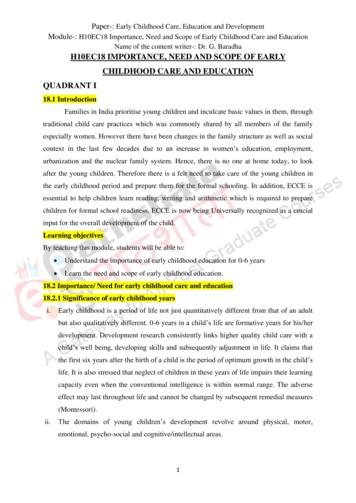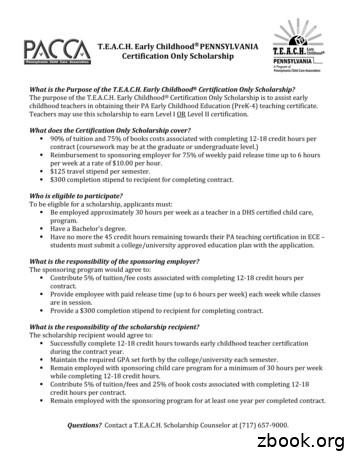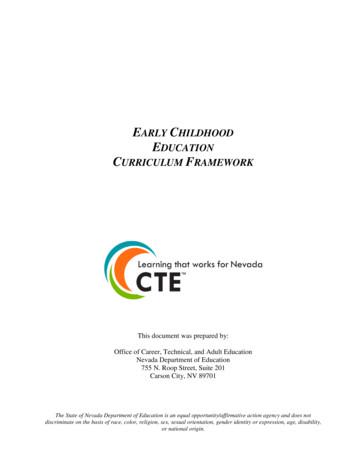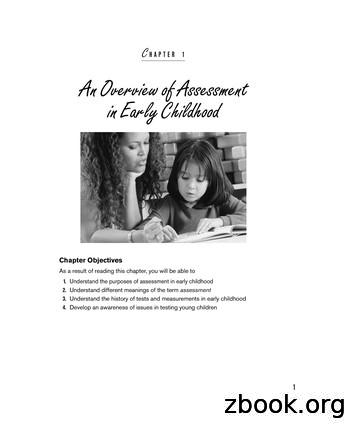International Journal Of Early Childhood Environmental Education
International Journal of Early ChildhoodEnvironmental EducationAddressing Policy, Practice, and Research That MattersISSN 2331-0464 (online) Volume 3, Number 1 North American Associationfor Environmental EducationWinter 2015
International Journal of Early ChildhoodEnvironmental EducationAddressing Issues, Policies, Practices, and Research That MatterISSN 2331-0464 (online)Yash BhagwanjiExecutive EditorFlorida Atlantic University, USABora SimmonsAssociate Executive EditorUniversity of Oregon, USAJudy BrausAssociate Executive EditorNAAEE, USACONSULTING EDITORSPatti BailieVicki Bohling-PhilippiKristi CooperCourtney CrimAmy Cutter-MackenzieJulie DavisCarolyn EdwardsBlanche Desjean-PerrottaJulie ErnstSue ElliottKen FinchChristine KiewraLeigh O’BrienMamata PandyaJenny RitchieMary RivkinIngrid Pramling SamuelssonKeum Ho ShinJulia TorquatiVicki StaytonRuth WilsonSusie WirthUniversity of Maine at Farmington, USAForest Lake Family Center, USAIowa State University, USATrinity University, USASouthern Cross University, AustraliaQueensland University of Technology, AustraliaUniversity of Nebraska, Lincoln, USAUniversity of Texas at San Antonio, USAUniversity of Minnesota Duluth, USAUniversity of New England, AustraliaGreen Hearts Institute for Nature in Childhood, USADimensions Educational Research Foundation, USAState University of New York Geneseo, USACentre for Environment Education, IndiaVictoria University of Wellington, New ZealandUniversity of Maryland - Baltimore County, USAUniversity of Gothenburg, SwedenDaegu University, South KoreaUniversity of Nebraska, Lincoln, USAWestern Kentucky University, USABowling Green State University, USADimensions Educational Research Foundation, USABOOK AND RESOURCE REVIEW EDITORSJill SmithBrenda WeiserCentral Methodist University - Missouri, USAUniversity of Houston - Clear Lake, USAEDITORIAL ASSISTANTSNuhad PiraniFlorida Atlantic University, USANorth American Association for Environmental Education (NAAEE)Promoting Excellence in Environmental Education – Environmental Education We Need for the World We WantJudy Braus,Christiane MaertensLori MannJose “Pepe” Marcos-IgaMary OcwiejaExecutive DirectorDeputy DirectorProgram and Conference ManagerPresidentEElinked, EEnews, & Member Services
International Journal ofEarly Childhood Environmental EducationISSN 2331-0464 (online)Volume 3, Number 1Winter 2015TABLE OF CONTENTSNote of ReflectionThe Essence of Our Collective Work5Ruth Wilson, Consulting EditorResearchThe green bean has to be longer than your thumb: Anobservational study of preschoolers’ math and scienceexperiences in a garden8Maureen Vandermaas-Peeler, Elon University, USACara McClain, Elon University, USABetwixt the Wild, Unknown and the Safe: Play and theAffordances of Nature within an Early Childhood Educationand Care Institution in Norway28Gjertrud Stordal, Queen Maud University College of EarlyChildhood Education, NorwayGro Follo, Centre for Rural Research, NorwayIngar Pareliussen, Queen Maud University College of EarlyChildhood Education, NorwayA Young Child’s Perspectives on Outdoor Play: A Case Studyfrom Vancouver, British ColumbiaA. Elizabeth Beattie, University of British Columbia, Canada38
Children as “Solutionaries”: Environmental Education as anOpportunity to Take Action54Elizabeth O. Crawford, University of North CarolinaWilmington, USANancy Luke, Western Carolina University, USAWilliam Van Pelt, HeartGift, USAPedagogyWild Beginnings: How a San Antonio initiative instills the loveof nature in young children72Deepti Kharod, Montessori, The University of Texas atSan Antonio, USAMaria G. Arreguín-Anderson, The University of Texasat San Antonio, USAAdvocacy and PolicyNature and the Outdoor Learning Environment: The ForgottenResource in Early Childhood Education85Allen Cooper, National Wildlife FederationChildren’s Books and Resources Review98Brenda Weiser, Book Editor, University of Houston, ClearLake, USAJill Smith, Book Editor, Central Methodist University,Missouri, USAInformation for Authors102
International Journal of Early Childhood Environmental Education, 3(1), p. 5International Journal of Early Childhood Environmental Education, 3(1)Copyright North American Association for Environmental EducationISSN: 2331-0464 (online)NOTE OF REFLECTIONThe Essence of Our Collective WorkRuth WilsonConsulting Editor“Telos” may not be a word commonly used in daily conversations, but the idea behind it is something I think aboutalmost every day. Telos – sometimes described as the essence of things – is what I had on my mind as a mule deerand I made eye contact during a hike in the Sandia Mountains yesterday. The deer seemed to be sizing me up –Who was I? Was I a threat? What was I doing in its territory? I, too, was asking questions – How does this deersurvive in the desert? Where does it find water? Is it afraid of me? I was trying to get a better understanding of thedeer, a glimpse into its telos. Perhaps it was trying to do the same of me. Today, I think about telos in relation toearly childhood environmental education (ECEE). Who are we? What is our purpose?I’ve been involved in ECEE for almost 25 years and sometimes still ask, “What’s it all about?” That’s where “telos”comes into the picture. Aristotle believed that everything has a purpose or final end. He called this its “telos” andsaid that if we want to understand what something is, it must be described or understood in terms of its end orpurpose. I now ask, what is the telos of early childhood environmental education? Is it the wellbeing of children orthe wellbeing of the natural world? It can be both, of course, but is that its telos?As I see it, ECEE is more than the integration or intersection of early childhood education and environmentaleducation. I’m not sure what that “more” is, but I think it’s something that merits consideration.My work in ECEE started in the early 1990’s while teaching at Bowling Green State University in Ohio. I taughtcourses in early childhood special education. My focus was on enhancing the learning experiences and lives ofyoung children with special needs. I felt positive interactions with nature were critical to the holistic developmentof children, yet I saw little opportunities for such interactions in early childhood education programs. I set out tochange this.My goal was to inspire and support teachers in connecting children with nature. I based my work on theunderstanding that nature-related experiences could foster a sense of wonder, and that wonder was a foundationfor learning. I also believed that nature and the wonder it engendered were, as Rachel Carson said, “an unfailingantidote against the boredom and disenchantments of later years, the sterile preoccupation with things that areartificial, the alienation from the sources of our strength.”I looked to the Environmental Studies program at the university and the Ohio Environmental Education Fund forsupport in integrating early childhood education and environmental education. My ideas were met with someskepticism. The director of the Environmental Studies program asked about the content of what we would beteaching young children – “What can you teach little kids – the sources of energy?” And a reviewer of grants forthe Ohio Environmental Education Fund commented, “I’m not sure we should be funding preschool projects. Isn’tpreschool just babysitting?” In spite of the skepticism, the project I proposed was funded.Many of the early childhood teachers I worked with welcomed the idea of incorporating nature into theirprograms; others were more hesitant. Some teachers expressed concern about not knowing enough about naturethemselves to teach it to children; others felt their curriculum was already full, with room for nothing else.
International Journal of Early Childhood Environmental Education, 3(1), p. 6Funding for my project included the purchase and review of related print and non-print materials – curriculumguides, activity books, videos, etc. I found that there were very few such resources available. There was also ascarcity of other types of resources such as guidelines, professional networks, and related research. At the time,even the North American Association for Environmental Education (NAAEE) had no publications and offered few, ifany, conference sessions or seminars focusing on young children. For those of us interested in ECEE, it was a lonelyworld. At one point, I did discover a network of early childhood educators in Australia focusing on environmentaleducation for the very young. My contacts with them proved to be inspiring and helpful.My focus, at first, was on working with teachers in early childhood education settings. I was soon contacted,however, by educators in nonformal settings (nature centers, zoos, and children’s museums). Some of them werealready working with preschoolers but were struggling with how to meet the needs of young children.So what we had until recently was early childhood education without the environmental component andenvironmental education without the knowledge and skills needed for working with young children. I saw thatintegrating the two fields would offer advantages to both, so that became my focus.I’m excited and pleased with the many developments in ECEE that have occurred over the past 20 – 25 years.There’s no doubt that we’ve come a long way, and this is cause for celebration. Yet, I sometimes sense that there ismore to come – that the “next big thing” may be right around the corner if we can keep the momentum going. Wehave guidelines, resources, model programs, and networks. We even have some impressive research supportingthe positive impact of our work. But are we clear about the potential, the ultimate purpose, the telos?We currently have two fields working together in a type of partnership, which includes a healthy sharing ofinformation, ideas, and resources. One image that comes to mind is the holding of hands – suggesting a “we’re inthis together” approach. We also have the image of hands holding the Earth. This image suggests to me that theEarth – with all its beauty and wonder – is the focus of our efforts. This is a beautiful image, but I wonder, does thepurpose of ECEE go beyond sustainability of the planet? Many of us have strong feelings about education forsustainability; but we also believe in education for peace and justice and respect for the rights of children. Is therea way to make these concerns a part of who we are?A Code of Ethics developed by Early Childhood Australia (ECA) calls on early childhood educators to “work withchildren to help them understand that they are global citizens with shared responsibilities to the environment andhumanity.” This statement, I believe, can provide some guidance on how to expand our thinking about who we areand who we might become, especially in its emphasis on both the environment and humanity.We often base our work in ECEE on the understanding that what we do is good for children and good for the Earth.The NAAEE Early Childhood Environmental Education Programs: Guidelines for Excellence reflects this dual focus,and related research supports our endeavors. Is it now time to ask where we go from here? Of course, we wantmore research on the effectiveness of what we do, more resources on how to best implement the guidelines wehave in place, and more dissemination of information both within and without the field of education.Perhaps we should consider going beyond what we sometimes accept as descriptions of environmental education(EE) and early childhood education (ECE)? EE, we sometimes say, is “education in, for, and about theenvironment.” Today, we also use the term “education for sustainability” to emphasize the importance of buildinga sustainable society – that is, a society that meets the needs of the present without jeopardizing the ability offuture generations to meet their needs.Early childhood education – the other part of ECEE – is often described as education that promotes the holisticdevelopment of young children. Here, the focus is on the child and what the child needs now and in the future toachieve his or her potential. ECE is also about the development of identity. This includes individual identity, socialidentity, and cultural identity. Recently, we’re recognizing the importance of promoting a positive ecologicalidentity during the early years, as well.
International Journal of Early Childhood Environmental Education, 3(1), p. 7It’s not hard to see why EE and ECE needed to come together to meet the goals or purpose of each. We know thatattitudes, habits, and dispositions formed during the early childhood years lay the foundation for the attitudes,habits, and dispositions we carry with us throughout life. The early childhood years, then, offer tremendousopportunities to foster the child’s understanding and appreciation of the natural environment as the basis of alifetime commitment to caring for the Earth. Tapping into the potential of these early years is perhaps our bestchance of developing an environmentally-concerned citizenry that will have the knowledge and will to relate to theEarth in a sustainable way. For EE to be maximally effective, it needs to include the early childhood years and do soin developmentally appropriate ways.But ECE also benefits from strong connections with EE. It’s becoming increasingly clear that positive interactionswith nature are essential to a young child’s holistic development. Without close connections with nature, a child’scognitive, emotional, psychological, and spiritual development is at risk of being compromised. Resources of theEE community can be tremendously helpful to early childhood professionals in connecting young children withnature. Consider, for example, the contributions of such EE initiatives as nature play, natural playspaces, andnature preschools on early childhood education and the lives of many young children.So now when asked what ECEE is all about, we can respond without hesitation that it’s about working for anenvironmentally sustainable future and the wellbeing of young children. But is this the essence, the telos – ormight there be more? Perhaps there is and perhaps it has to do with the making of beautiful people.The idea of beautiful people emerged out of a professional forum focusing on the integration of peace, nature, andspirituality as a way to enhance or transform early childhood education. This forum – supported by the BiosophicalInstitute and hosted by the Schlitz Audubon Nature Center in Milwaukee – consisted primarily of professionalsfrom both the early childhood and environmental education fields. We asked ourselves what we wanted asdesired outcomes of our educational programs for young children. As a part of this discussion, we considered howwe would like a child to finish the statement, “I am a person who . . .”By the end of the day, we had a list of dispositions, attitudes, and inclinations we would like to see fostered in ourprograms. This list included empathy, respect, attention, quiet reflecting, appreciation of diversity, and the abilityto adapt to different situations. These desired outcomes, we felt, would result in the making of beautiful people –that is people who live with a sense of wonder, sensitivity to beauty, respect and compassion for others, a deepappreciation of the natural world, and an interest in creating a more peaceful, just, and sustainable world.Can the idea of making beautiful people help define the telos of ECEE? Doing so would expand the idea of whatwe do as being “good for children and good for the Earth” to include “good for society.” And if we decide that ourgoal is the making of beautiful people, how do we go about doing this?Should our emphasis be on empathy, compassion, wonder, or something else? What should we look to as the hubor heart of what we do? The Chicago Zoological Society is committed to fostering a “culture of empathy” andconsiders this as being critical to their conservation mission. Their goal is to be a vehicle for positive social changein a way that includes but extends beyond the realm of conservation. What about ECEE? Where should we set oursights? What do we want our telos to be?As we stand and view the world around us, we sometimes ask “What’s it all about? What keeps it going? Are theredimensions below the surface that we’re only beginning to understand? Today, as we stand and view theemerging field of ECEE, we might use these same questions to set a course for the future. We might also considerhow we would like to complete the sentence, “We’re a network of people who . . .”Giving serious consideration to these questions may help us define a telos for ECEE that is greater than the sum ofits parts. Perhaps we’ll discover alchemy at work moving us toward the shaping of a more beautiful future. Wegave birth to ECEE; we can now nurture and support its growth to help it become all that it can be.Ruth Wilson is Professor Emeritus at Bowling Green State University in Ohio and currently resides in Albuquerque, New Mexico.She may be contacted at wilson.rutha@gmail.com.
International Journal of Early Childhood Environmental Education, 3(1), p. 8International Journal of Early Childhood Environmental Education, 3(1)Copyright North American Association for Environmental EducationISSN: 2331-0464 (online)The green bean has to be longer than your thumb:An observational study of preschoolers’ math and science experiences in a gardenMaureen Vandermaas-PeelerCara McClainElon UniversitySubmitted April 27, 2015; accepted June 16, 2015AcknowledgementsThe authors would like to thank the participating preschool community, including the teachers, parents andchildren. Support for this project was provided by Elon University with a faculty research grant to the first authorand undergraduate research funds to the second author. Permission to use photographs was granted by parentsand the preschool.AbstractSchool gardening has become increasingly popular as a context for learning in which children construct newknowledge, learn cultural and societal values related to ecological awareness, and develop and practice authenticor real-world skills (Blair, 2009; Bowker & Tearle, 2007). The present research was a longitudinal case study ofchildren’s gardening experiences at a Reggio-inspired preschool in the United States. Eleven children and theirteacher were observed over nine days in various activities such as preparing the garden beds, planting, andharvesting. Through sustained participation in a variety of gardening activities, preschoolers engaged in sciencerich dialogue utilizing complex and abstract science process skills such as observing, predicting, evaluating, andcomparing. Discussion of number-related concepts, spatial orientation, and size estimation and comparison wasalso recurrent during gardening activities. In addition, analyses of social interactions and dialogue related togardening knowledge and ecological awareness indicated that working in the garden was an authentic context forenjoying, learning about, and valuing the natural world. The results of this study support the conclusion that withappropriate teacher guidance, a preschool garden affords myriad opportunities for young children to developmathematical and scientific thinking, ecological awareness and positive affective responses to the natural world.Keywords: school gardens, Reggio Emilia, preschool, early childhood, mathematics, scienceThe present research was a longitudinal case study of children’s interactions with a teacher in a garden at a Reggioinspired preschool in the United States. The research utilized a social constructivist theoretical framework in whichchildren’s cognitive and social development is fostered through participation in meaningful social and culturalpractices (Rogoff, 2003; Peterson, 2009). Everyday experiences that build knowledge and skills are critical foryoung children’s early scientific and mathematical learning, two areas that have been understudied in preschoolsettings but are critical for subsequent school achievement (Duncan et al., 2007; Linder, Powers-Costello, &Stegelin, 2011; Peterson, 2009). Reggio Emilia is a social constructivist early childhood approach with a holisticview of learning and development, in which children are viewed as active agents or “researchers” who constructtheir own knowledge and teachers serve as co-learners and guides who help to facilitate children’s discovery andlearning in indoor and outdoor environments (Hewitt, 2001). The garden was selected as the research context forthis observational study because growing, harvesting and eating the produce are authentic, engaging andmeaningful experiences that provide numerous opportunities to practice and develop mathematical and scientificskills and reasoning, as well as to build ecological awareness and an affinity and respect for the natural world.
International Journal of Early Childhood Environmental Education, 3(1), p. 9Early math and science experiences within a social constructivist perspectiveYoung children’s developing knowledge and skills are constructed through participation in dynamic and reciprocalcultural practices and traditions (Kumpulainen & Renshaw, 2007; Rogoff, 1990; Vygotsky, 1978). Research onmathematics, for instance, has highlighted the diverse pathways through which authentic problems are solved insocial situations in various cultural contexts, including the extensive measurement practices of the Kpelle inLiberia, arithmetic expertise of street vendors in Brazil and purchasing knowledge of elementary school AfricanAmerican students in an urban neighborhood (Nasir, Hand & Taylor, 2008). Findings from cross-cultural studiesconfirm the premise that these culturally relevant, routine experiences across contexts “both shape and constituteour learning” (Nasir et al., 2008, p. 193).Scholars have emphasized the importance of young children’s early math and science learning in the course ofeveryday activities, but there is a dearth of research on how much, and under what conditions, childrenincorporate mathematical and scientific understandings into the course of daily activities (Tudge & Doucet, 2004).More research examining young children’s use of math and science concepts in daily activities is needed, especiallyconsidering that mathematical knowledge at school entry has been found to be the strongest predictor ofsubsequent school achievement (Duncan et al., 2007).In early childhood educational settings, a social constructive approach to teaching math and science includes acurriculum with a diversity of engaging, meaningful activities and an inquiry-based approach in which teachers askchildren open-ended questions designed to facilitate problem-solving and reasoning (Gelman & Brenneman, 2004;Linder et al., 2011). Recent research suggests that children need repeated exposure and practice using relevantmath and science language in the context of interconnected, meaningful activities (Gelman & Brenneman, 2004).According to Clements (2001), high quality preschool approaches should “invite children to experiencemathematics as they play in, describe and think about their world” (p. 270). In his view, based on extensiveresearch and practice, preschool teachers should plan activities that simultaneously involve cognitive, socioemotional and physical development, and build on children’s informal knowledge and experiences. A holisticapproach acknowledges and extends preschoolers’ high levels of motivation and self-directed learning.The Reggio Emilia Early Childhood ApproachReggio Emilia is an internationally recognized holistic early childhood education approach, founded by LorisMalaguzzi after WWII as part of a post-war reconstruction effort in the Italian city of Reggio Emilia (Edwards,Gandini, & Forman, 2012). Researchers have increasingly turned to Reggio Emilia as an exemplar of a high-qualitysocial constructivist approach (e.g., Clements, 2001; Edwards et al., 2012; Edwards & Willis, 2000; Hewitt, 2001;Inan et al., 2010; Kim & Darling, 2009; Linder et al., 2011). In the United States and elsewhere in the world, theterm “Reggio-inspired” has come to symbolize early childhood educational approaches that incorporate many ofthe central tenets but also adapt the pedagogies to their own unique cultural context.Reggio-inspired pedagogies feature a child-centered approach in which children create meaning from daily lifeexperiences through planning, coordination of ideas and abstraction (Gandini, 2012). The teacher’s role is tofacilitate learning through listening and knowing when to intervene. Through a process of documentation, teacherscapture ongoing learning processes in photographs and detailed transcripts of the children’s activities. Long-termprojects based on children’s enthusiasm are co-constructed between adults and children (e.g., Ghirotto & Mazzoni,2013). Foundational principles of Reggio Emilia include the following: the idea of multiple intelligences (known ashundred languages in Reggio Emilia); the importance of design and aesthetics in the physical environment;collaborative relationships between children and adults in the community; and attention to all aspects of diversity(Edwards et al., 2012).The Reggio Emilia approach encourages children to engage with math and science in the course of daily eventsinside and outdoors. By engaging in inquiry, or the processes of observing, questioning, predicting and evaluating,children construct knowledge and learn to coordinate evidence and theory, particularly when guided andencouraged by adults (Bourne, 2000; Inan, Trundle, & Kantor, 2010). In a qualitative study of natural sciences
International Journal of Early Childhood Environmental Education, 3(1), p. 10education in a Reggio-inspired preschool, Inan et al. (2010) found that children’s inquiry was a high priority for theteachers because they believed it was the basis for children’s abilities to make sense of the world. Inquiry wasfostered through a science-rich culture, and the use of science terms such as “theory,” “hypothesis” and“prediction” were often observed in teachers’ and preschoolers’ language. Questioning, searching, andinvestigating were valued and utilized rather than having teachers deliver facts (Inan et al., 2010). Thus, theemphasis was on science process skills utilized in the course of everyday experiences.Another central theme of Reggio-inspired preschools is that the natural environment is a third educator (Torquati& Ernst, 2013). Educational spaces are designed to be welcoming, aesthetically pleasing and supportive of multipleways of learning. Reggio educators utilize a diversity of materials and experiences that afford different possibilitiesfor actions on the environment (Edwards & Willis, 2000). While outdoors children can explore natural phenomenasuch as changing seasons, the habitat of animals, or growing food crops. Extant research supports the conclusionthat outdoor environments can foster holistic and integrated learning, particularly when teachers believe in thebenefits and provide educational opportunities and guidance (Ernst & Tournabene, 2012; Maynard & Waters,2007). Reggio-inspired schools utilize outdoor spaces to increase children’s awareness of the natural world as theyparticipate in ongoing projects and play outside throughout the seasons. Gardens are a prominent feature,teaching children about topics such as taking care of land and growing food (Thornton & Brunton, 2009).Gardens as a context for learningSchool gardening has become increasingly popular as a context for learning in which children construct newknowledge, learn cultural and societal values related to ecological awareness, and develop and practice authenticor real-world skills (Blair, 2009; Bowker & Tearle, 2007). Extant research on school gardens has focused on foodsystems ecology and nutrition education, the benefits of positive experiences with the natural world andenvironmental stewardship, and learning outcomes related to math and science-education opportunities (Blair,2009; Chawla, 2007; Miller, 2007). In an international project investigating children’s experiences in schoolgardens, Bowker and Tearle (2007) found that children developed complex conceptual maps linking theirgardening experiences and knowledge with ecological awareness. Children in all three countries also had strongpositive affective responses to gardening. Miller (2007) found that when participating in garden activities, youngchildren developed important skills in a breadth of domains, including personal growth and academic learning.Research by Skelley and Bradley (2007) showed that third-grade students who participated in gardening activitieshad positive attitudes towards science, and that teachers reported using gardens to instill positive environmentalattitudes. Parmer et al. (2009) found that gardening was associated with positive influences on children’svegetable consumption and preferences, as well as increased fruit and vegetable knowledge.In the United States, the number of school gardens has increased considerably in recent years (Lekies & Sheavly,2007; Skelley & Bradley, 2007). However, the majority of research on school gardening has been conducted inelementary school settings, and less is known about preschoolers’ interactions in this context (Blair, 2009; Miller,2007). In addition, little is known about how children’s interests in gardening develop over time (Lekies & Sheavly,2007). Preschool is an ideal time for learning about the environment, given children’s interest in the naturalenvironment and their developmental readiness for observation and hands-on learning (Witt & Kemple, 2007).Through their experiences in the natural world, children not only learn to enjoy their time outdoors but alsoprepare to become environmental stewards (Chawla & Cushing, 2007).PURPOSE AND DESIGN OF THE STUDYThe present
Early childhood education - the other part of ECEE - is often described as education that promotes the holistic development of young children. Here, the focus is on the child and what the child needs now and in the future to . identity during the early years, as well. International Journal of Early Childhood Environmental Education, 3(1), p.
Understand the importance of early childhood education for 0-6 years Learn the need and scope of early childhood education. 18.2 Importance/ Need for early childhood care and education 18.2.1 Significance of early childhood years i. Early childhood is a period of life not just quantitatively different from that of an adult
T.E.A.C.H. Early Childhoodâ PENNSYLVANIA Certification Only Scholarship What is the Purpose of the T.E.A.C.H. Early Childhood Certification Only Scholarship? The purpose of the T.E.A.C.H. Early Childhood Certification Only Scholarship is to assist early childhood teachers in obtaining their PA Early Childhood Education (PreK-4) teaching certificate.
Early Childhood Education I L1 Early Childhood Education II L2 Early Childhood Education III L3C Early Childhood Education Advanced Studies AS The core course sequencing with the complementary courses provided in the following table serves as a guide to schools for their programs of study.
CHAPTER 1 An Overview of Assessment in Early Childhood Understanding Assessment in Infancy and Early Childhood Not too long ago, resources on early childhood assessment were limited to occa-sional articles in journals, chapters in textbooks on teaching in early childhood pro-grams, and a few small textbooks that were used as secondary texts in .
ECE 240 - Administration of Early Childhood Care and Education Programs (3) ECE 241 - Administration: Human Relations for Early Childhood Education (3) Colorado Mesa University B.A. Early Childhood Education - Early Childhood Special Education Advisor: Vail Shoultz-McCole vshoultz@coloradomesa.edu 970-255-2674
Early Childhood Care, Development and Education (ECCDE) is a term that is used interchangeably worldwide but refers to the same concept of early childhood education and cognitive development. The World Bank for instance refers to it as Early Childhood Care and Education, whereas UNESCO refers to it as Early Childhood Development Care.
publication to an early childhood newsletter, journal, electronic journal, etc. Present on an Early Childhood education topic at the UCO Student Symposium. Attend a workshop, seminar, institute, etc. related to early childhood education Participate in Week of the Young Child activities, for a minimum of 4 hours. Participate in a
Conduct an API-653 inspection of your tank every five years as recommended by TFI (The Fertilizer Institute) WHAT IS THE API 650 SPECIFICATION API - AMERICAN PETROLEUM INSTITUTE Worldwide Standard for Above Ground Storage Tank Design and Construction Provides requirements for calculations of shell plate thickness, man-way and nozzle design Provides procedures for shell, roof and floor .























